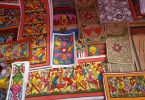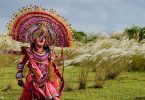West Bengal’s Purulia district has a traditional rich cultural heritage. This cultural heritage of Purulia is popular as the Chhau masks. To tell the truth, this mask is the main thing that marks the difference between the Chhau dance of Odisha and Purulia.
However, Purulia Chhau dance has the use of mask while the other does not. This mask is both traditional as well as unique.
Baghmundi block, 300 km from Kolkata is a district in Purulia, which has 500 families residing there. Their main profession is making of the Chhau masks. Another place, Charida which is about 5 km from Baghmundi village. It is on the Ayodhya Hills, scenic foothills. This place has as many as 150 artist families.
Many upper-caste family youngsters are also taking up the art of mask-making. During old times, only the low-caste people used to do it but nowadays, these caste-based divisions are fading away.
The masks rates start from ₹700 and if the crafts work is much higher in the mask, the rate can go up to ₹4000. There is a yearly Chhau mask festival during December-January in Charida. The Chhau mask craftsman has gone to France and Japan for showing their work and hence popularising Chhau.
The artist revenue hikes during the winter season and slows down during summer. The masks have a simple and frank yet bold look. Each of the masks represents some of the characters from the Puranas, mythology and epics.
We can buy Chhau masks online too. Moreover, we can use the Chhau masks for decorating our homes. Even, we can keep the masks at the entrance of our house. To tell the truth, it serves as a perfect gift item. The Chhau mask serves good ethnic decoration.
History of Chhau Mask:
If we look back during old times, when there was the rule of Baghmundi’s king Madan Mohan Singh Deo, from that point of time, making of Chhau masks tradition started. Similarly, the age-old Purulia dance forms are associated traditionally with the Chhau mask.
Theme and style of Chhau Mask:
The Purulia Chhau dance mask is used mainly for mythological characters. Some of these characters are the Rama-Sita, Mahishasur-Mardini, the fight of Rabana and Rama, etc. Small Santhal couple masks are used sometimes. This mask has some unique features within itself such as the face of it is surrounded by ornaments and feathers, that can be to our amazement from the mask itself, extended two feet.
To tell the truth, they colour the masks to portray Gods and Goddesses such as bright orange or dark yellow for Lakshmi, Kartik, Devi Durga. White for Ganesh, Devi Saraswati and Lord Shiva. Dark blue or black for Maa Kali. Along with this, they use tilak on Rama and Krishna’s forehead and thick moustaches of dark green or black for the Asuras. In addition, they give large eyes and teeth in these masks to provide it with a more special look.
Manufacture of Chhau mask:
To tell the truth, the Sutradhar community artists make the Chhau masks. The making of Chhau masks involves different procedures. It has soft papers of 8-10 layers, immersed in diluted glue. Further, they paste these soft papers simultaneously one after another on the mud mould. To our amazement, they dust fine ash powder on the mud mould after pasting the paper layers.
The process of mask making takes about two to seven days. To tell the truth, they use high calcium content soil used for plastering the mask. In addition, they cannot make the masks in the rainy season or weather.
To make facial features, generally, they use clay. A small river flows through the banks of Charida. They collect the mud from this place. In addition, they apply a combination of cloth and mud special layer in the mask. Then they keep the masks for sun-dry. A special type of soil, that contains high sand content is applied on the mask. After sun-drying, there is polishing of mould. Next, the sun-drying second round of the mask takes place. Then, they separate the layers of paper and cloth from the mould. Further, the mask goes through the process of holes drilling for the making of the nose and eyes and carving. Added to this, they use wooden too for giving the shapes to the masks.
As a matter of fact, they use pastel shades in the painting of the masks. At last, to decorate the mask they use ribbons, leaves, beads, artificial flowers and colours.
Geographical Indications of Chhau Mask:
The List of Geographical Indications in India has Purulia’s Chhau mask registered with them. The mask is unique and in fact traditional as the Purulia Chhau has some basic differences with the other.
Chhau dance:
The Chhau dancer wearing the mask gave a benevolent look and feel to the audiences viewing it. It is a form of dance that is very popular in Jharkhand, West Bengal and Orissa. The origin of Chhau dance is in Orissa’s Mayurbhanj.
Generally, March-April months is the ideal time for the performance of the Chhau dance, which is the Chaitra ending time. They use the episodes of the Puranas, Ramayana, Mahabharata in the Chhau dance. Local people and many other tourists also love to view the performance of the Chhau dancers.
However, Chhau dance has use of many drum types. The Chhau dance gives us an expectation to drive away from the evil forces and spreading of the right things among us. The beating of drums marks the beginning of the dance followed by Lord Ganesha’s invocation.
Chhau dance has three variations in three different Eastern India states Mayurbhanj Chhau of Orissa, Seraikella Chhau of Jharkhand and Purulia Chhau of West Bengal.
Usually, the Purulia Chhau and Seraikella Chhau use Chhau masks. But, normally the Mayurbhanj Chhau, does not follow the use of these masks. As a form of entertainment, the Chhau dance can be performed at any time at any festival. Dancers from the three Indian states travel to different areas for their performance.



